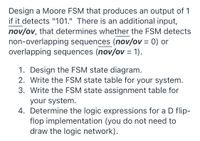
Database System Concepts
7th Edition
ISBN: 9780078022159
Author: Abraham Silberschatz Professor, Henry F. Korth, S. Sudarshan
Publisher: McGraw-Hill Education
expand_more
expand_more
format_list_bulleted
Question

Transcribed Image Text:**Design a Moore FSM for Sequence Detection**
When designing a Moore Finite State Machine (FSM) to detect the sequence "101," you will encounter an essential feature to consider — whether the FSM should handle non-overlapping or overlapping sequences. An additional input, *nov/ov*, determines this behavior:
- **Non-overlapping sequences**: *nov/ov* = 0
- **Overlapping sequences**: *nov/ov* = 1
**Tasks:**
1. **Design the FSM state diagram.**
- Create a visual representation of states and transitions for the FSM that accurately detects the sequence "101" based on the specified type (overlapping or non-overlapping).
2. **Write the FSM state table for your system.**
- Develop a table that lists all states, inputs, next states, and outputs for the FSM.
3. **Write the FSM state assignment table for your system.**
- Assign binary codes to each state, which will be useful for implementing the FSM with digital logic.
4. **Determine the logic expressions for a D flip-flop implementation.**
- Calculate the logic necessary for each flip-flop that will help store the state of the FSM. You are not required to draw the logic circuit but provide the expressions.
This design effectively distinguishes between sequences where the detection includes pure sequences and those where the sequences overlap, offering a comprehensive understanding of sequence detection.
Expert Solution
This question has been solved!
Explore an expertly crafted, step-by-step solution for a thorough understanding of key concepts.
This is a popular solution
Trending nowThis is a popular solution!
Step by stepSolved in 4 steps with 4 images

Knowledge Booster
Learn more about
Need a deep-dive on the concept behind this application? Look no further. Learn more about this topic, computer-science and related others by exploring similar questions and additional content below.Similar questions
- Please zoom into the image if it is difficult to seearrow_forwardAssume an FSM has inputs a and b. Which transitions are correctly formed? States has two outgoing transitions, one with condition ab, another with a'b. State s has two outgoing transitions, one with condition a, another with b. State s has two outgoing transitions, one with condition ab, another with (ab). State s has three outgoing transitions, one with condition ab, another with a'b', and a third with a'b.arrow_forwardAssume we are writing a testbench for a sequential circuit that has three control inputs (cA, cB, cC) and a periodic clock (clk). If we define CLK_PERIOD as a localparameter with a value of 50 (nsec), write the testbench segment that would ensure all possible combinations of the control inputs were tested on a clock rising edge. This is can be done more elegantly if you define each time step in terms of the constant CLK_PERIOD. Your answer should include the statements that define clk, cA, cB, and cC over time. Hint: think of how you would show all combinations of three variables on a truth table and replicate that over time, where each combination is held over a timespan with a clock triggering edge.arrow_forward
- Design a Moore FSM for a Sequence Derector that detects five consecutive bits of "zero" in the input stream of bits, labeled x. The output z equals 1 if, during five consecutive clock cycles, the input x was equal to "zero". Once the sequence is detected, the FSM returns to the initial state S0. Add an asynchronous reset, active low, to the FSM.arrow_forwardFor the K-map where the X input is down and the Y input is across, which one of these is a simplified expression? F(x,y)=y F(x,y)=x'+y' F(x,y)=x+y' F(x,y)=(xy)' F(x,y)=x+y F(x,y)=xyarrow_forwardConsider this state transition process for an FSM with 2 states. Write a truth table for the state signal as a function of the current state and the input x.Write a truth table for the output Y as a function of the current state.Implement the next state logic using a CLB logic slice.arrow_forward
arrow_back_ios
arrow_forward_ios
Recommended textbooks for you
 Database System ConceptsComputer ScienceISBN:9780078022159Author:Abraham Silberschatz Professor, Henry F. Korth, S. SudarshanPublisher:McGraw-Hill Education
Database System ConceptsComputer ScienceISBN:9780078022159Author:Abraham Silberschatz Professor, Henry F. Korth, S. SudarshanPublisher:McGraw-Hill Education Starting Out with Python (4th Edition)Computer ScienceISBN:9780134444321Author:Tony GaddisPublisher:PEARSON
Starting Out with Python (4th Edition)Computer ScienceISBN:9780134444321Author:Tony GaddisPublisher:PEARSON Digital Fundamentals (11th Edition)Computer ScienceISBN:9780132737968Author:Thomas L. FloydPublisher:PEARSON
Digital Fundamentals (11th Edition)Computer ScienceISBN:9780132737968Author:Thomas L. FloydPublisher:PEARSON C How to Program (8th Edition)Computer ScienceISBN:9780133976892Author:Paul J. Deitel, Harvey DeitelPublisher:PEARSON
C How to Program (8th Edition)Computer ScienceISBN:9780133976892Author:Paul J. Deitel, Harvey DeitelPublisher:PEARSON Database Systems: Design, Implementation, & Manag...Computer ScienceISBN:9781337627900Author:Carlos Coronel, Steven MorrisPublisher:Cengage Learning
Database Systems: Design, Implementation, & Manag...Computer ScienceISBN:9781337627900Author:Carlos Coronel, Steven MorrisPublisher:Cengage Learning Programmable Logic ControllersComputer ScienceISBN:9780073373843Author:Frank D. PetruzellaPublisher:McGraw-Hill Education
Programmable Logic ControllersComputer ScienceISBN:9780073373843Author:Frank D. PetruzellaPublisher:McGraw-Hill Education

Database System Concepts
Computer Science
ISBN:9780078022159
Author:Abraham Silberschatz Professor, Henry F. Korth, S. Sudarshan
Publisher:McGraw-Hill Education

Starting Out with Python (4th Edition)
Computer Science
ISBN:9780134444321
Author:Tony Gaddis
Publisher:PEARSON

Digital Fundamentals (11th Edition)
Computer Science
ISBN:9780132737968
Author:Thomas L. Floyd
Publisher:PEARSON

C How to Program (8th Edition)
Computer Science
ISBN:9780133976892
Author:Paul J. Deitel, Harvey Deitel
Publisher:PEARSON

Database Systems: Design, Implementation, & Manag...
Computer Science
ISBN:9781337627900
Author:Carlos Coronel, Steven Morris
Publisher:Cengage Learning

Programmable Logic Controllers
Computer Science
ISBN:9780073373843
Author:Frank D. Petruzella
Publisher:McGraw-Hill Education